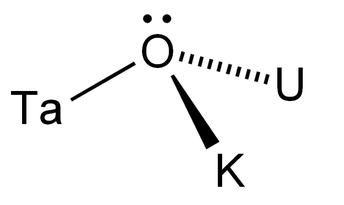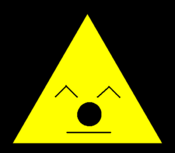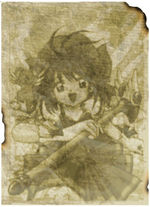Anime
An anime is a chemical compound that contains the anime group, which consists of one oxygen atom, one tantalum atom, one potassium atom, and one uranium atom, with a total charge of negative one (OTaKU-). Anime compounds can be divided into two groups: animo acids and animo salts.
General properties of animes
Animes tend to be highly volatile and dangerous, even when diluted. Most animes are known to enlarge the eyes of anyone who ingests them, and many have other adverse effects, such as creating a popped vein in the drinker's right temple. Also, animes are required to have at least one attractively-drawn main character — one who the viewers are guaranteed to fall love with.
Addictive properties
Prolonged exposure to animes can result in serious anime addiction. A number of studies on the subject of anime addiction have shown that even so little exposure as looking at an anime can be enough to afflict some. Teenagers are particularly vulnerable to anime addiction; in laboratory conditions, teenagers are advised to keep away from any anime they see and to not experiment with any foreign-looking chemicals that could be animes.
An opposite and more common reaction caused by exposure to anime is a deep feeling of unnatural hatred directed towards the chemical. People using it for this purpose usually do so to redirect feelings of hostility away from themselves or other people at a harmless substance.
Reactivity of anime
Animes often tend to react with several other groups of chemicals.
For instance, by adding several kinds of alcohol to a solution of animes, helium, nitrogen, tantalum, and iodine can be combined to form HeN(TaI), a molecule that, once created, causes all nearby molecules to undergo neuron decay. Scientists are exploring this chemical reaction to see if it is possible to create some sort of energy source by doing so. To that end, researchers at Tokyo Tech have found a way to mass produce this new compound by harnessing the raw power of Japanese tears and blood.
Animes do not react well with mysterious colored liquids. When combined with these, anime usually tends to explode in a semi-comical corona of light, afflicting those in the general area with a briefly passing chibi affliction.
New research by Western researchers has shown that it is possible to synthesize Animes using Western technology. However, it has been found that many of these results are either shoddily made or degrade too quickly into HeN(TaI).
Anime extraction process
Animes are very rarely found in their purest state. In most cases, they must be extracted from large, complex, solid manganese compounds called manga. These compounds exist in this special class because they are the only ones in which manganese is known to go extra hyper with an oxidation number of 15. The reducing process required involves collecting the manga from manga deposits, submerging the compound in a sufficiently dissolving solvent (such as water), reducing it with very strong reductants (such as Bandai) and refining the resulting anime.
Further reducing already refined animes is sometimes called "dubbing" due to the "dub-dub" sound the anime makes upon releasing foreign impurities. During this stage, anime salts and acids are separated. In many instances, the refining process also releases the by-product, manganese animide (OTaKOMnU) or various complexes of which. Although it appears a further anime group could be extracted from such a product, the other unusual oxidation state of 1 for manganese in it means there is currently no known way to take the animes away from them.
Anime extraction is a very delicate process, and improper care in the second reducing phase can lead to pure anime of remarkably low quality. Although some animes exist that are known for their successful dubbed solutions, most are considered to be far inferior to the original dissolved anime mineral, much less the original manga ore, especially in such areas as durability, luster, and keeping the words synced up to their freaking lips.
Anime naming conventions
Animes are named in a system radically unlike other chemicals. Most chemicals are named using a combination of their constituent ions or groups; however, animes are often named based on their physical characteristics, sometimes on their historical uses, and sometimes on a seemingly random sequence of words. This has led to a great deal of disagreement, conflict, and badly written hate mail among chemists, but the system is still the most common in use today.
Animo acids
Animo acids are the more reactive, violent, huge-sword-sporting type of animes. Most animo acids have the general structure H[M]OTaKU, where [M] is anything with a formal charge of zero. Exceptions include acids with a negative ionic component, such as tentacle animo acid (see below). These are called polyprotic animo acids; they contain multiple H+ ions, which usually end up as bad spinoffs or movies when dissolved in aqueous solution. Animo acids tend to be utilized by such chemists as ninjas, pirates, and shinigami.
Examples of animo acids
- Ninja animo acid – named so because it is often applied to ninjastars to make them deadlier.
- Pirate animo acid – named so because it is often applied to piratestars to make them deadlier.
- Alchemic animo acid – mentioned in old alchemical texts as having numerous transmutative properties, though its initial users warned of danger to one's limbs if the exchange of atoms is not kept equivalent at all times.
- Animo acid on acid – the history behind its name is unknown, and frankly quite frightening.
- Animo acid for fuel – Animo acids are commonly used in substitute for Sentai compounds in giant robots. The advantage of animo acid is clear, when used in Mobil Suits, animo acid generally has the potential to make such machines faster than most any Sentai compound fueled robot, which at best only have the potential to look like they're going fast, simpler, making most robots pilotable even by average teenagers, and in some "unique" cases, even semi-sentient.
- Tentacle animo acid – a strong animo acid which contains a saturated solution of HeN(TaI)-. It is one of the few naturally occurring animo acids; it is commonly found in the tentacles of octopi. It is sometimes called a "hentai" acid due to the formula of its negative ionic component. Although tentacle acid has little adverse affects on living beings, it dissolves clothes completely, especially schoolgirl uniforms.
Animo salts
Animo salts tend to be far less dangerous than animo acids, although they react just as easily. Most animo acids simply consist of the anime group coupled with any number of alkali metals, although some sport alkaline earth or even transition metals (these usually result in more bishōjo-ish salts, due to the increase in OTaKU- ions). Animo salts are typically sported by schoolchildren in love.
Examples of animo salts
- Sailor animo salt – though having nothing to do with sailors, this salt is a popular condiment among young girls, in large part due to an urban legend of "magical" properties.
- Fruity animo salt – this salt was formerly believed to be found in fruits and to have anthropomorphic properties.
- Love animo salt – a purported love potion when dissolved in aqueous solution. In reality, it just got members of the opposite gender to make fun of the drinker.
Animo base
- Main article: Bleach (base)
Bleach is the only known base to contain the anime group. It reacts completely with most animo acids and is considered a strong base despite lacking a chemical structure resembling any other strong bases. Most attribute this to its extreme amounts of spiritual energy.
In popular culture
Animes have a large cultural impact, both inside and outside the chemical world. One of the largest examples of this is the phenomenon known as the anime convention, at which proponents of anime use gather to discuss anime-related topics, such as improvements on refining, popular use, effect on the global economy, and cosplay, or dressing up as one's favorite animo acid or salt. This latter subject, in fact, makes up the vast majority of anime convention activity; many anime followers actually seem to have no business at conventions whatsoever aside from displaying their elaborate and time-consuming costumes before the only audience that will appreciate them.
Medical concerns
Studies have shown that induviduals, in particular, teenagers, that are exposed to Anime compounds, will spontaneously get bloody noses. Much research has been done into this phenomenon, but no conclusive data has been gathered. One possible reason scientists explain, is because the Anime acids somehow expand blood cells in the nasal region, causing capillaries to rupture. Teenagers are warned to only use Anime acids in moderation. Of course, teenagers, being teenagers, ignore this warning completely. Those exposed to Anime acids, have particularly violent, if not explosive nosebleeds, around schoolgirls in skirts, and feminine boys crossdressing as schoolgirls, or bishounen characters. A known trigger for said nosebleeds, are panties. However, scientists are only discovering the correlation of panties to the nosebleeds and Anime acids.






